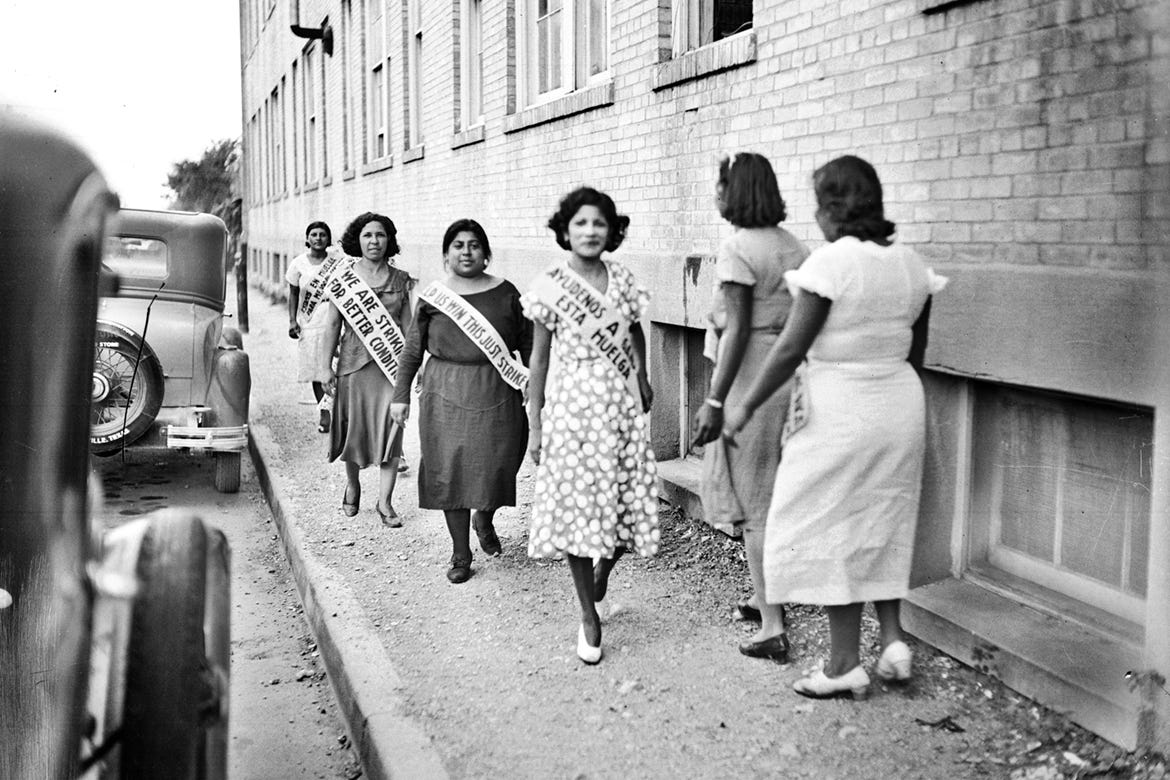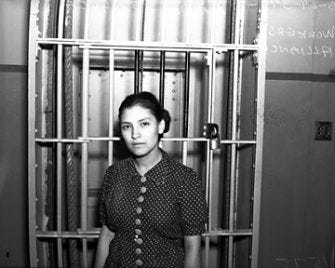the teen girl who led the biggest strike in texas
emma tenayuca fought for labor protections and intersectional workers' rights, way before she could work herself
i once read a story about a man who wanted to swim, so he bought a bunch of books to learn about it. once he finished those books, he watched swimming competitions and studied swimmers. once he finished that, he went to his local pool and observed swimmers, creating detailed drawings of their every move and planning out his first dip. once he finished that, well, he had grown old and physically incapable of swimming.
today, those books are social media, and “swimming” is fighting against the system. we know something’s wrong, we know we want to fix it, but we just can’t find it in us to go. and so we scroll endlessly, collecting information on all the ways we’re being screwed over, without actually doing anything. if emma tenayuca had been born 100 years later, her talents might have evaporated behind thinkpieces and infographics. but luckily she wasn’t and led the one of the largest workers’ strike in american history.
emma tenayuca was the oldest child born to a poor, working class family of 11 in san antonio, texas. as a teen growing up during the early 1930s, emma’s family was hit hard by the depression. she opted to live with her grandparents to ease the burden on her parents (typical eldest daughter vibes).
emma’s grandparents were “the woke friends,” constantly debating politics at home which intrigued emma. every sunday, emma and her grandfather would go to the local plaza del zacate to hear anarchists and activists speak about workers’ rights from their soapboxes (side note: being on your “soapbox” very literally translates to people in this era standing on boxes used to transport soap, and giving speeches.) it was here she saw not just the suffering of workers, but the unique suffering of mexican-american workers — underpaid, overworked, and excluded from a lot of the new deal’s jobs and housing programs. additionally, people from mexico were facing mass deportations due to fears that they were stealing the already-sparse jobs from white americans.
what i like about emma is she wasn’t some untouchable godlike figure. she was a teenager who engaged in her version of doomscrolling - watching speeches at the plaza, - she read karl marx, studied how to organize strikes and called herself an anarchist.
since you got to start somewhere, emma joined her first strike at age 16, with the all-women staff of the finck cigar company.
police violently broke up the strike and arrested many women, including young emma. the experience shook her as she realized that the right to protest and freedom of speech looked very different for people who looked like her. from this strike, to the speeches in the plaza, to her own family’s struggles, emma began to see what economic desperation did to people: it didn’t make them work harder, it made them hopeless. and what sliver of hope they had to fight for a better job got violently shut down. emma then knew she had to dedicate her life to fighting for workers.

in 1934, now 18 years old, emma began volunteering with garment workers. she helped form two local branches of the international ladies’ garment workers union. emma quickly butted heads with the union leadership, who she felt did not understand the needs of the mexican american community. mexican workers were paid less than white workers, especially women. they were often assigned to dangerous jobs without protections and - as they still do today - faced the threat of deportation. employers and even union leaders would threaten deportation to keep mexican workers from demanding better treatment. and so emma once again decided to take her talents elsewhere - namely, the communist party.
from ages 19-20, emma had led several marches, demonstrations, and sit-ins to protest discrimination against ethnic mexican workers. she also served as a translator between spanish-speaking workers and unions. by 21, emma was the general secretary of at least ten workers alliance chapters, representing thousands of workers who had been unemployed by the depression. she was truly doing it all.
emma was light-skinned and of spanish descent, which allowed her more degrees of protection and bargaining power. i scoured the internet to find what she was doing for money, to have so much time and energy for her advocacy but didn’t find much. 100 years later, i guess it doesn’t matter because her legacy holds so much more than that. in 100 years, no one will remember that i couldn’t go attend protests because i was too busy with work.
“we can no longer wait for better days without fighting for those better days!”
-emma tenayuca, 1937
you may have never guessed it but san antonio used to be an industry city. you know, the way la is an industry city (meaning, the majority of the working population works within or connected to a singular industry). except san antonio’s chief employer wasn’t films, it was pecans. pecans! how texan.
the realities of this industry were far less sweet though. in the 1930s, the entire nation’s pecan production was controlled by san antonio-based southern pecan shelling company. the company was based in san antonio’s westside where mexicans and mexican-americans made 40% of the population. as a result, many sought employment as pecan shellers. their working conditions were deplorable. the employees worked 10 hours a day, 7 days a week in overcrowded rooms with only one bathroom — all for $2-3 weekly. yes, you read that right, weekly. many workers even took pecans home and enlisted the help of their families in cracking open the nuts, hoping the additional work would result in more money or appreciation. to make matters worse, shelling pecans released a type of dust that caused tuberculosis.
emma recognized an industry in dire need of organizing.
the 1938 pecan-shellers strike is what emma is most known for. on january 31, 1938, almost 12,000 workers at over 130 plants walked off the job to protest their low salaries (1 cent per pound of pecans shelled) and unsanitary working conditions. a 21-year-old emma was elected by the workers - mostly mexican american women - to lead the strike and under her command, the strike became the largest the city had ever seen - and one of the largest and longest workers’ strikes in the united states.
during the three months of the strike, almost 1000 strikers were arrested. workers who were mexican and/or darker skinned received the most brutal and violent treatment from police. the media did not focus on the strikers’ demands for living wages, rather fixated on the fact that emma had “communist ties,” at a time in the united states where being a communist equaled being a terrorist. emma and fellow organizers endured weeks of “red-baiting” - being harassed and/or persecuted because of suspected communist ties. police justified their use of excessive force against the workers because they were “just trying to protect from the communist revolution.” side note has anyone ever asked a communist-hater what exactly they hate communism?
the workers unanimously decided to cut ties with emma because her communist ties were distracting from the cause, yet emma was still involved in negotiations and raising awareness of the strike. the police violence began to attract national attention as people were horrified seeing these small brown women enduring so much brutality and hate. 37 days later, the strikers and the pecan company agreed to arbitration, with the strikers winning a small wage hike and recognition of their union.
unfortunately, the pecan workers victory was short lived. just a few months later, president FDR enacted the fair labor standards act that established a minimum wage of 25 cents per hour - even more of a wage increase than the one they negotiated for. the southern pecan shelling company responded by laying off 10,000 workers and opting for machines over human labor. their newly recognized union ceased to exist.
***
for the decade after, emma continued to face harassment from people and the government. in 1939, a communist meeting she held was stormed by 5,000 anti-communist protestors leading to 23-year-old emma having to escape san antonio and live under a pseudonym. the fbi had kept a massive file on her and possibly blacklisted her from working any government job, considering she tried a few times to gain employment and was rejected for no apparent reason. in the 1940s, emma left the communist party when they began aligning with the soviet union and stalin’s terror regime.
emma dedicated herself for the rest of her life to obtaining a teaching education and worked as a teacher in san antonio until 1982. although she was no longer a public figure, she stayed involved by mentoring students who were interested in activism. she died in 1999, a few years after being inducted into the san antonio women’s hall of fame.
“I just have a feeling, a very strong feeling, that if ever this world is civilized, that it would be more the work of women.”
-emma tenayuca, 1930s
the spirit of emma lives in so many of us yet the action, not so much. i’m not going to blame social media for making us inhibited — recent shme-portations by shm-ice have everyone hesitant to speak up. but we don’t have to speak up about everything. emma tenayuca felt called to advocate for her san antonio community of mexican workers - a community within a community - and ended up making a significant difference in their lives: imagine getting a wage hike during the depression! and her staunch advocacy for one group caught attention nationally, eventually playing a part in the fair labor standards act getting passed. uplifting one community makes a greater difference than trying to uplift everyone! just look at bad bunny! vs, like, tate macrae (sorry tate i do love sports car!)
too often we think dipping into the pool of activism means standing up for absolutely everyone and every cause. and so we read up on all of them and by the end of the day are too exhausted to even try. i say enough of that. here’s your (and my) homework: find an organization, nonprofit, or group in your neighborhood that interests you and inquire about how to get involved. make it as easy for you as possible. and start there. because emma tenayuca didn’t start with leading 12,000 pecan workers with the intention of getting them out of the great depression and getting national attention — she began attending a small protest with people she didn’t even know.
so jump into the pool. don’t read up on it, don’t step into it slowly - jump. because by the time we finish “getting educated” it’ll be too late.
sources: women and the american story, the nation, museo del west side, houston culture, zinned project






